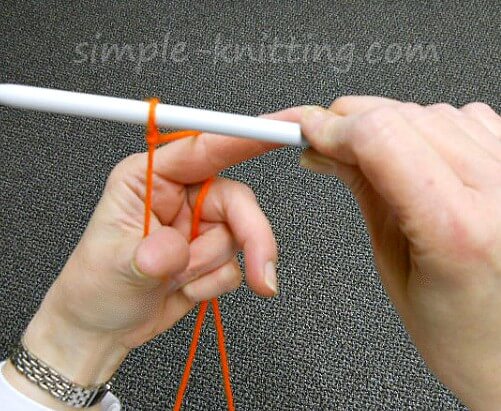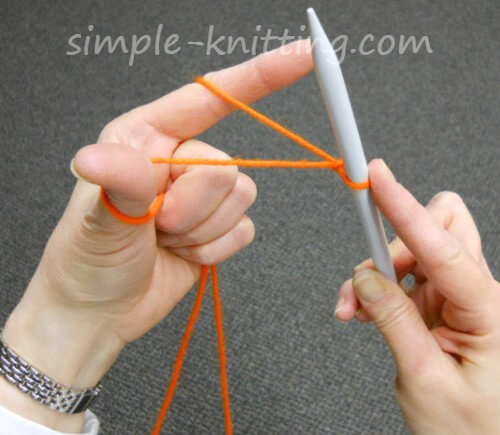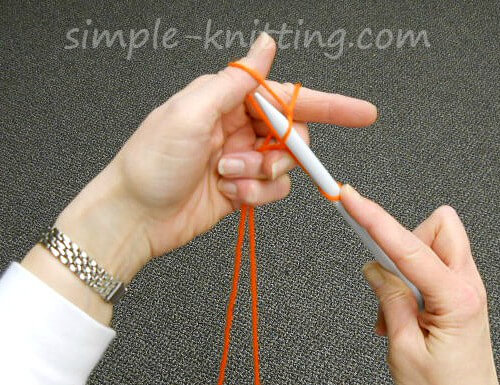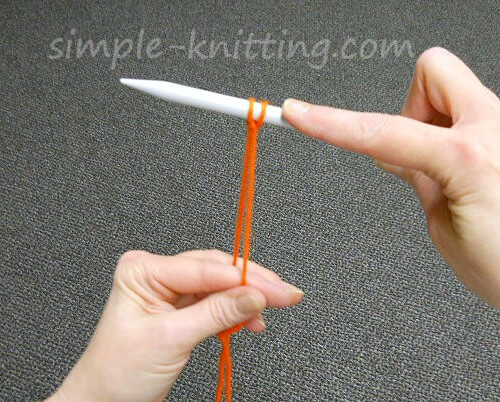- Home
- Knitting Instructions
- Long Tail Cast On
Long Tail Cast On Method
The long tail cast on or double cast on is one of the most popular and quickest cast on knitting methods.
Once you know how I bet it's going to be one of your favorite cast ons for knitting
It creates a nice firm, stretchy, edge making it just right for most knitting projects and it actually produces a knitted row.
So what that means is when you turn your work to begin knitting you're first row, you can actually start with a purl row if you want too.
The biggest challenge with this cast on is making sure that you leave a long enough tail to cast on all your stitches. Here are two ways to try:
1. Use a tape measure and allow one inch per stitch. So for instance, if you were to cast on 20 stitches then allow 20 inches for stitches.
Then you'll need to add an extra 4 - 6 inches for weaving in so measure out 24 - 26 inches. I also keep the tape measure taut and the yarn pretty loose.
2. Wrap the yarn around the needle the same amount of times as the amount of stitches you need. Don't wrap too tightly.
Also keep them evenly spaced out to get a more accurate count. Each wrap is a pretend stitch so that you can measure.
If you have to cast on 30 stitches wrap the yarn around the needle 30 times. Or, wrap the yarn 10 times and measure that length, then triple it for 30 stitches.
The trick to this method is to keep the stitches nicely spaced on the needle and make sure they aren't too tightly wrapped.
The Long Tail Cast On Method Just Got Easier
Here's a great knitting tip for not having to estimate the length of yarn to use. Of course you will still need this step-by-step tutorial but when you're done you can check it out.
I use it all the time especially when I need to cast on lots of stitches. Clicking this link will take you to my knitting tips page and I will show you how to long tail cast on without having to estimate the yarn tail
Long Tail Cast On Instructions
Make a
slip knot
and place it on your needle. Hold your knitting needle in your right hand with both strands of yarn hanging down.
Keep the tail end closest to you and the working yarn (ball end) furthest away. Now proceed with the cast on instructions.
Note: Instructions are just below each photo.
1. With your left hand put your thumb and forefinger together and stick them between the two strands of yarn.

2. Spread your thumb and forefinger apart with the tail end over your thumb and the working yarn over your forefinger. Hold the dangling strands of yarn in the palm of your hand.

3. Raise both your hands so they are kind of level with each other. When you're holding the right needle use your forefinger to hold the slip knot on the needle.
Then gently pull the right needle back a bit so that you have what looks like a sling shot.

4. Then insert the right knitting needle under the yarn on the outside of the loop at the bottom of your thumb.
In the photo above my knitting needle is pointing to where you need to insert the needle.

5. Keeping the strand of yarn from the thumb on the needle slowly move your needle over to the tip of your forefinger.
In the next two photos below you're going to catch the yarn on your forefinger.

5a. Move the needle over to your forefinger Then catch the yarn on your forefinger with the right needle

Step 6. 2nd photo of catching yarn on your forefinger

Step 7. Slowly bring the needle back and through the thumb loop. (This photo and one below)

Step 7a. Gently pull your thumb out leaving the new stitch on the knitting needle.

Step 8. Just after thumb was pulled out leaving loop on needle

Step 9. Tug on the long tail end of yarn gently to snug up the new stitch on the needle - not too tight.
And you're done.
For those of you who prefer to watch, this is a great knitting video demonstrating the long tail cast on method. It also shows you how to cast on without needing a slip knot.
Long Tail Cast On Knitting Video
If you're happy with this cast on method and you're anxious to get started with knitting you can head over to the next knitting tutorial, the knit stitch or...
If you'd like to try all the casting on knitting methods click on the link and try another one. After all it's nice to know how to do a few cast ons.


